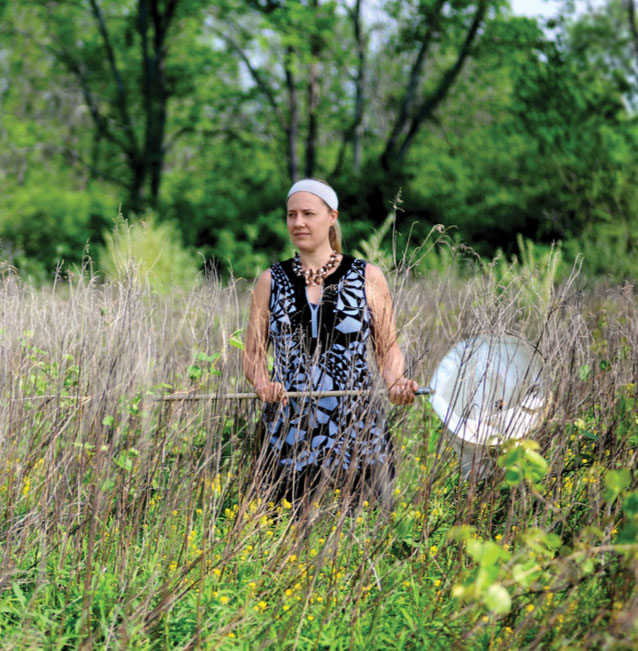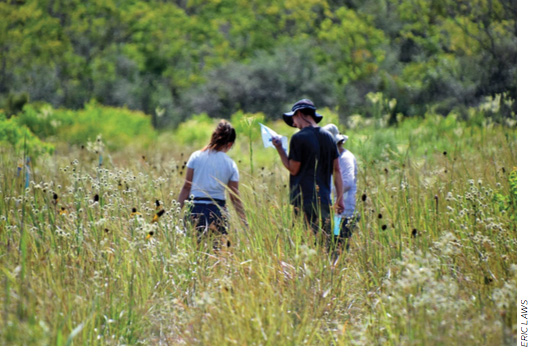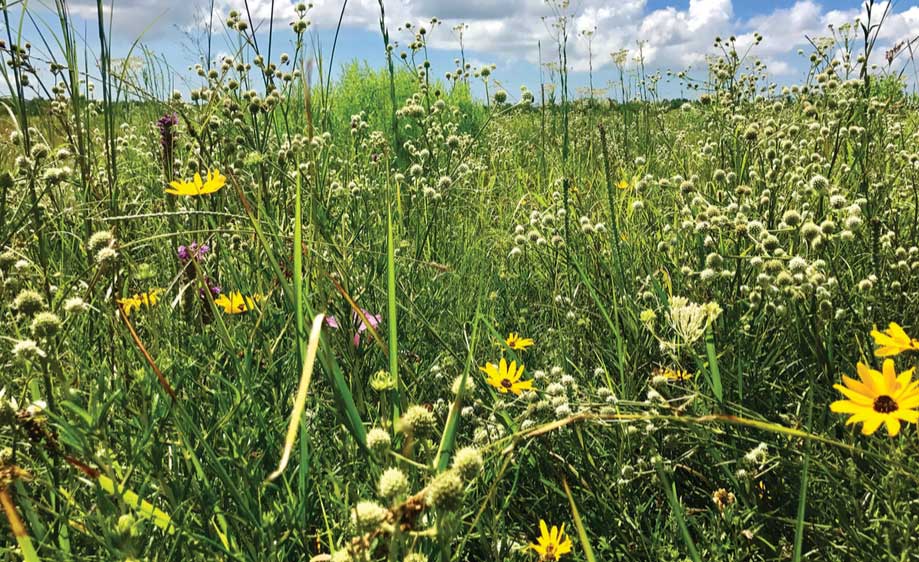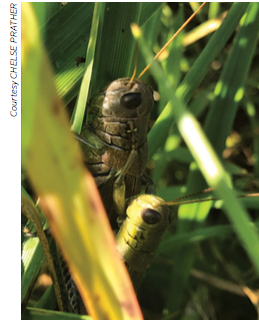On the prairie
It was the middle of the night in Dayton, Aug. 25, 2017, but Chelse Prather kept waking up to watch the live video feed of Hurricane Harvey slamming into Texas.
Problem was, it was the middle of the night in Galveston, too. All she could see on the screen was black.
“I was texting a lot with my friends when it was hitting. I was worried about our friends staying safe,” said ecologist Prather, an assistant professor of biology. “I was also worried about this experiment.”
Prather was more than two years into field work on a half-million-dollar research project. Like any good hurricane, Harvey had sucked up the warm waters of the ocean and let them rain down over land — in this case, on her experiment site, a coastal tallgrass prairie 13 miles inland from Galveston. In the next two days, 43 inches of rain would fall on the plants and animals living there.
First, there was the question of what the rain would wash away. But there were also questions about what the rain would bring, most likely calcium and sodium, abundant in seawater. Problem is, for the two previous years, Prather had carefully and deliberately manipulated the quantities of these and other nutrients on the prairie.
Her goal is to better understand the effects of human-induced environmental change, specifically if a combination of practices as common as agricultural fertilization and irrigation could be setting us up for a plant-eating insect boom — insects that devour food we intend for ourselves and our livestock. Planet-wide, humans are changing the distribution of plants and animals while also altering the abundance of nutrients available for life to grow.
What would become of her experiment?
“I call it the confounding factor of the hurricane,” Prather said.
So, with Harvey still raining down but much of the danger having passed, she asked friends in Texas to brave the rain and stake Tupperware containers to the ground to collect Harvey rainwater, and send water samples back to Dayton. If she could figure out what was in the water, she could use the information to adjust her data and just maybe collect one of the first before-and-after comparisons of the impact of hurricanes on the prairie.
She’d have to wait until May to see the prairie — and what the hurricane left behind — for herself.
More than 1,100 miles from
UD, the University of Houston Coastal Center is paradise for an ecologist looking to understand the relationships between plants, insects and the micronutrients — minerals such as calcium, potassium and sodium — both need to thrive.
Paradise, that is, if you overlook the suffocating heat, biting insects and dewberry thorns that tear at your flesh and open wounds ready to scream at the next application of sunscreen.
“It takes a certain kind of person to thrive,” said Prather, who for four summers has handpicked students to join the research project, supported by a $546,599 award from the National Science Foundation. “You have to be real comfortable with being uncomfortable.”
Prather knows the Texas heat well. In 2011, she joined the UH Coastal Center as a postdoctoral fellow at a time when the center was looking to attract significant government funding. She and collaborator Steve Pennings, professor of biology at UH, submitted and refined the prairie micronutrient study three times before receiving the coveted and highly competitive grant.
The research is focusing on grasshoppers, important for the native ecosystem but a bane to ranchers and farmers, who spend $1 billion annually to control the plant-eating insects. The U.S. Department of Agriculture is interested in Prather’s results and added $150,000 in funding to monitor grasshopper diversity in a related collaboration with UH research assistant professor Angela Laws.
“This type of information could actually help us predict [grasshopper] outbreaks better and has lots of implications for how we manage these systems,” Prather said.
UD added funding through its STEM Catalyst Initiative — in 2017 for a collaboration with biology colleague Yvonne Sun to analyze how changes in nutrients affect the grasshopper’s gut, and in 2018 to support the related research of her graduate students.
One of those students, Ryan Reihart ’14, is focusing on the tawny crazy ant, named for its fast, erratic movements. It’s a non-native species that’s invading the South. In cities, it’s eating wiring and shorting out televisions in homes. In 2012, it scurried into Prather’s experiment site. Reihart is on the forefront of discovering how diet might either contain or encourage the ants.
Reihart, who trapped and counted 51,000 crazy ants last summer, was worried Hurricane Harvey might have drowned all of his prairie-dwellers. But a researcher visiting in winter reported some colonies had survived.
A doctoral student on Prather’s Insect Ecology Lab team who previously received an undergraduate degree from UD, Reihart headed to Texas in May for his second summer of prairie fieldwork. This summer he is joined by master’s student Emily Jones and recent May graduates Shania Hurst and Kiersten Angelos, plus four students from UH. They are spending long days setting traps for ants to fall into, counting and clipping plant species, digging soil samples and twisting insect nets through the breeze in a hypnotic dance. They are also helping Jones set up experiments that could determine if three interconnected invasive species, including the crazy ant, are helping one another to spread.
For Reihart, it’s a welcome opportunity to sink into the grasses and immerse himself in the field.
“We also try to have fun, too, while we’re out there,” Reihart said. “It can get hot, and we can get hungry and cranky, but we always just make it fun, like who can do [the task] the fastest. ... It’s just awesome being outside, being with people who are fun in the field.”
In wet summers, prairie grasses can grow 8 feet tall, a sea of rustling green and nodding flower heads — first yellow sunflowers, then the brilliant green of the plant Rattlesnake Master, before finally erupting in the late-season purple blooms of the native Blazing Star. Long, hot, wet growing seasons result in lots of data for scientists to work with.
“These are really gorgeous prairies that have upwards of 600 species of plants, and we’ve recorded 800 species of insects,” Prather said.
Prather said it’s a rare privilege to work in a coastal tallgrass prairie — less than one-tenth of one percent of the nation’s coastal prairies still exist, primarily because they are so good at producing the rich soils coveted for agriculture.
This prairie survived Houston’s boom thanks in part to World War II. Formerly known as Camp Wallace, the site was used by the military for training antiaircraft units and then as a naval boot camp. In recent years, a garbage dump grew to the west, a dog-racing track to the north and a highway to the east, reserving the interior 1,000 acres of prairie and woods for today’s many researchers. Last year, the Texas state legislature acknowledged the importance of the center by designating it the Texas Institute of Coastal Prairie Research and Education.
On Google maps, you get a bird’s eye view of the grid mowed into the interior prairie, more than 29 acres divided into 128 plots. It’s the beating heart of the Insect Ecology Lab’s work.
During 2016 and 2017, Prather and her students donned safety glasses and wrapped bandanas around their mouths and noses. By the handful or with the help of a four-wheeler, they spread 10 tons of fertilizer each year on the plots in different nutrient combinations. Among the choices for their fertilizer combination were the micronutrients calcium, potassium and sodium — required in trace amounts for plant and insect growth — and the macronutrients nitrogen and phosphorus, now abundant in most soils thanks to common agricultural practices.
The goal, Pennings said, is to determine if combinations of nutrients result in plots that are more habitable — and plants that are tastier — to the herbivore insects. These would be nutrient combinations ranchers and farmers might wish to avoid.
If certain fertilizer combinations result in less tasty plots, they could be used as an alternative to current methods of pest control, often involving blanket pesticides on cropland and ranchland.
Pennings, who is also director of the UH Coastal Center, said the results could have wider implications. Take the northern United States, where communities commonly treat icy roadways with products that include calcium and sodium. Or in the Plains States, where irrigation practices bring water higher in sodium to agricultural lands.
“If sodium or calcium turns out to be important, are we unwittingly increasing grasshopper populations?” Pennings asked.
Prather can sit in her office in Sherman Hall and share facts that would make most people squirm — like that the average home has 100 species of insects living among its humans. (She does point out that, without the insects that eat dead insects, you’d be more aware of just how many you cohabit with.)
It’s hard to believe there was once a time when every insect made her scream in terror.
When she was 5, her well-meaning father, intent on helping a young Chelse conquer her fear, had her extend a shaky finger to touch the shiny emerald armor of a docile Japanese beetle.
As she did, another beetle swooped down and snagged the green bug for its lunch.
“I was really freaked out, but I think it spurred something in me — ‘What in the world just happened?’” she said. “I needed to discover for myself that there was all this stuff going on in the natural world all around you all the time. You’re not thinking about it, and the fact is that most people are not thinking about it.”
As an undergraduate at University of Kentucky, Prather said fieldwork got her excited to pluck rocks from a stream and wonder at the multitude of insects living underneath. As a doctoral candidate at the University of Notre Dame, she followed insects called walking sticks through the forest floor in Puerto Rico to better understand their eating habits and how that influenced the rainforest ecology.
With her long blond hair pulled back in a perpetual braid, and her nails trimmed to the quick, she has an air of being ready to bolt outdoors at any moment.
“Most of us were the kids outside playing in the mud, catching every animal that we saw in the yard, and I’ve heard a lot of ecologists say we just never really grew out of that,” she said. “I love that that can be a permanent part of my job and that I get to introduce that to students.”
As an assistant professor at Radford University in Virginia from 2014 to 2016, she enjoyed making science accessible and applicable to her undergraduates. In one class, they updated the Wikipedia pages of the insects they were researching — and then counted the web hits. “By the end of the class, the pages that 13 students had updated had been viewed 1.5 million times,” she said. “It’s interesting and fun for the students to do work related to science that will have people other than scientists as the receivers of that work.”
While at Radford, Prather realized her NSF grant required the intensive attention only graduate students could provide, and Radford did not have a graduate program in biology. She chose to make the move to the University of Dayton, in part because she said she takes the role of graduate mentor very seriously.
“You’re trying to teach somebody how to be an independent scientist,” she said of her graduate students. “The fact that it was a small program meant that I could give the students the type of attention they need — and deserve.”
She’s also maintained an interest in cultivating tomorrow’s researchers through opportunities for undergraduates. This year, nine undergraduates volunteered in Prather’s lab. Among them was Amanda Finke.
As a sophomore, Finke started work by pulling Ziploc bags of prairie soil from the freezer. She’d open the bags — letting free the sweet prairie scent trapped inside in Texas — and then carefully separate roots from soil.
Her volunteer duties were small tasks on the half-million-dollar micronutrient project, but Finke said Prather took the time to give her the big-picture explanation. Finke said it helped her understand how her work contributed, and also how the mind of an ecologist teases out tasks for such a complicated project.
Prather also encouraged Finke to find her own research path.
In May, Finke graduated with a bachelor’s in environmental biology and a year of Ohio prairie research under her belt. This summer, as a UD master’s student, Finke continues her investigation of insects found in Dayton area prairies. Just as Prather is doing, Finke is looking beyond the plants to the insects to gauge the health of the ecosystem.
“It’s what I do,” Finke said of her ecology research. “I can’t imagine not doing it now.”
She said Prather teaches students how to be good scientists while also navigating what it means to be a career scientist — including chasing the grants and writing the results.
“You can tell how passionate she is about her work,” Finke said, “and it gets you excited that she’s excited.”
Master’s student Jones used the words “driven” and “motivated” to describe Prather. In fieldwork last summer, Jones said she marveled at the speed at which Prather counted the species of plants growing there.
“We don’t know how she can possibly do everything she can, and that’s inspiring to be around someone that is capable of juggling all the things she does and is succeeding,” Jones said.
The 35-year-old mother of a 4-year-old son, Prather acknowledged that when the public and students alike conjure the image of an outdoor ecologist, her face does not spring to mind.
“I didn’t participate in science in high school because of this stigma — if you’re a scientist, you’re a dork,” she said. “And it’s a shame that part of it is still there, that stigma still exists. You can tell by the number of people who commonly participate in class.”
 Pennings said scientists like Prather are changing the perception of an ecologist and passing it on to a new generation.
Pennings said scientists like Prather are changing the perception of an ecologist and passing it on to a new generation.
She’s also part of a change happening within the field. Pennings points to the NSF’s Long-Term Ecological Research Network. LTER is unraveling ecological science and sharing information in ways beneficial to other ecologists as well as policymakers and resource managers. Having participated in research at the Luquillo LTER site in Puerto Rico, Prather also imparts a new way of learning to her students.
“Chelse’s a prime example of carrying the mindset out into the ecological community and being comfortable as a collaborator, being comfortable with the idea of sharing data, which was not part of the ecological culture in the past,” Pennings said.
At a brown bag session, Prather asked her students their opinions on the major issues in ecology worth looking into. It was a daunting task, said one grad student, but it began to open for them the world of interrelationships — within nature and among researchers — that are vital for the field to evolve.
Prather will take her quest for collaboration a step further in coming months. After publication of her findings, she plans to make the raw data from her macronutrient experiment available online for anyone to access. It should help other researchers interested in building on her work or applying it to other ecosystems — or even other natural disasters.
“For me it’s important to understand these bigger patterns,” Prather said. “The interesting thing about asking these big, complex questions is whatever you’re trying to understand depends on the context. The question I think I’m more interested in is is there generality in that context dependency: Can we predict how things will act depending on a set of circumstances?”
Back in Texas, Prather and her students in May unloaded a couple of vehicles full of equipment and ventured out into the coastal tallgrass prairie, their first chance to collect data since Hurricane Harvey. Before they left Dayton, they knew the hurricane had destroyed the greenhouses and lab building. What they had yet to discover was if all the supplies — carefully labeled and stacked for this year’s fieldwork — could be salvaged, and how the plants and animals had responded to 43 inches of rain.
During the hurricane, Pennings was one of those standing outside collecting rainwater. As he watched the neighborhood bayou overflow and creep ever-closer to his house, Pennings placed a blue 5-gallon bucket on his concrete patio. “I had to empty it twice, 24 hours apart, because it was overflowing,” he said. He poured the water in Ziploc bags, and then mailed samples to Dayton.
Prather discovered the quantity of sodium and calcium that fell on her experiment in two days equaled half of the micronutrients she would expect the prairie to receive in a year from average rainfall.
Results from fieldwork in 2017 showed nutrients do indeed make a difference, both in the types of plants that grow and the insects that feed on them. Sodium was the surprising standout. In plots that received the common fertilizers nitrogen and phosphorous plus sodium, insects were 1.5 times more widespread. One species of katydid was especially happy with the combination and increased its population 400 percent. Reihart also uncovered a connection between calcium and crazy ants.
Said Pennings, “We found that micronutrients mattered. What’s less clear is the mechanism.”
Grasshoppers might have preferred the variety of plants that thrived in the sodium plots. It also could be that the leaves themselves taste better with more sodium, or that sodium is a nutrient the insects crave.
“In the same way as in human health, the first order thing you have to do is get enough food,” Pennings said. “But once you’ve got enough food, you start thinking about all the vitamins, is my diet balanced, am I getting the right mixture of different things.”
This summer, they’ll be trapping grasshoppers and giving them a buffet of food choices to better understand the attraction of a high-sodium diet. They’re also in the rare position to compare the prairie before and after a major hurricane. Prather said she expects plots treated with only nitrogen and phosphorous may start to resemble the macronutrient-plus-sodium plots from last year and have more grasshoppers and katydids.
It’s hard to predict. Nature has a lot of natural variability, Prather said. But that means when you find an influence on the environment, you’ve made a discovery in spite of the odds.
While this is the last summer for fieldwork on the NSF project, Prather is eyeing future research opportunities on the UH prairie. She’s also looking to build off the Dayton prairie research of her undergrads, uncovering even more about local insects and their role in the ecosystem.
As she sat in her office, she paused from discussing the project for just a moment, eyes focused on the trees beyond her window. It looks like she’s about to head outdoors again. There’s more to do.
“It really is something that you ask one question,” she said, “and it only uncovers 10 more.”

